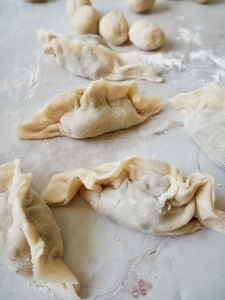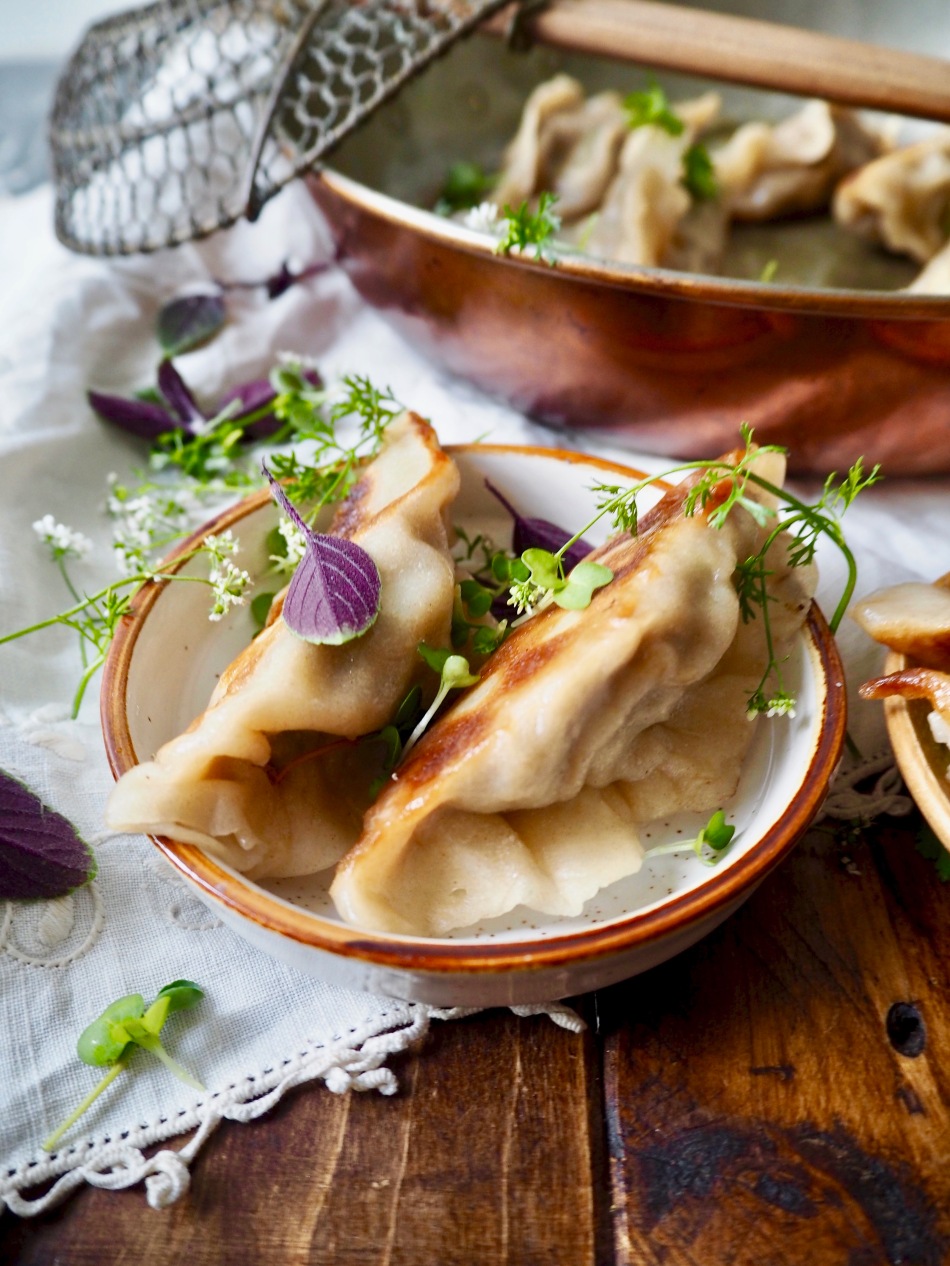 Although dumplings (or ‘gyoza’ or ‘potstickers’) are one of my favourite foods, I actually only tried them for the first time six years ago when I was in the States on a J1 student visa.
Although dumplings (or ‘gyoza’ or ‘potstickers’) are one of my favourite foods, I actually only tried them for the first time six years ago when I was in the States on a J1 student visa.
I was up visiting friends in New York for a few days and whether I asked or they urged, I don’t remember but somehow or another we ended up in a steamy café in Chinatown on a sweltering summer’s day eating rounds of cheap, delicious dumplings (a batch of the steamed ones first, then fried) and drinking bubble tea.


While the bubble tea made it no further in my culinary affections – I still squirm thinking about that creepy exploding texture – the dumplings fast became one of my favourite foods. Whenever I see them on a menu I order them, and to this day I’ve never met a dumpling that I didn’t love.


Although I only tried them for the first time on that trip to America, dumplings had actually long been a focus of my imagination, having encountered the idea as a child through a strange American manual for pre-teen girls that I had bought myself with my pocket money in Hodges Figgis.
As well as giving all sorts of advice on hairstyles, sports, friends, pets, boys and dealing with ‘zits’, it also offered, somewhat improbably, a recipe for ‘potstickers’ amidst a mix of other recommendations that were by turns helpful, outlandish or faintly terrifying.


Given the amount of steps involved and the association with what was, in retrospect, a pretty weird book, I never dared to try making them, but nonetheless the idea of pot-stickers stayed in my head throughout my childhood as a tantalising, exotic-sounding emblem of American-Asian cuisine, an idea that loomed larger still when I read Amy Tan’s evocative novel The Joy Luck Club as a young teenager, which is about four Chinese American women in San Francisco who meet to play mahjong, gossip and eat together, with the hostess of the evening serving up a feast of special, symbolic foods to bring good fortune to her guests – “dumplings shaped like silver money ingots, long rice noodles for long life, boiled peanuts for conceiving sons, and of course, many good-luck oranges for a plentiful, sweet life.”

After eating some pretty decent gyoza from a supermarket recently I decided I should give making them a go. Because that strange potstickers recipe has been on my mind for about a decade and a half, urging me to try it from a dusty cardboard box of books in an attic somewhere, I decided to make them from scratch, but using pre-made dumpling wrappers from an Asian grocery store will work just as well and will cut the prep time in half. Pork mince also works beautifully in these, as do diced sugar snap peas, shredded savoy cabbage and other vegetables.

PRAWN, MUSHROOM & SPRING ONION DUMPLINGS
Makes 24 dumplings which will serve 4-6 comfortably; halve the recipe if cooking for two

For the dumpling dough
175g plain white flour
175ml boiling water
A small pinch of salt
Place the dough in a bowl with the salt and mix in the water with a spoon. Bring it together using your hands then transfer to a floured surface and knead for around 4 minutes, or until smooth. Leave it in the fridge to rest for 20 minutes then cut the ball of dough in two. Cut each section into 12 even pieces then roll each of the 24 balls into spheres. Flour the surface and roll each of the balls out as thinly as possible. If the surface and the rolling pin are reasonably well floured, the dough shouldn’t stick but if it does, just add a little more flour. Use a large sized cookie circular cookie cutter to cut out a circle from each piece of rolled-out dough. Set the dough circles aside till you’re ready to start making the dumplings.
Or, alternatively, just buy a packet of dumpling wrappers (also called gyoza wrappers; wonton wrappers are said to be a little too thin for frying) in an Asian grocery store and proceed from here!
For the dumpling filling
185g fresh raw large prawns
150g chestnut or other brown mushrooms, cleaned
2 spring onions, trimmed & diced
1 inch piece of ginger, peeled & diced
2 cloves of garlic, peeled & diced
Small handful of coriander, diced
1 tablespoon of soy sauce
1.5 tablespoons of sesame oil
Generous pinch of black or white pepper
Tiny, tiny pinch of salt
Place the prawns in a large bowl and add the garlic, ginger, pepper, soy sauce and sesame oil. Blend to a paste using a hand blender. Dice the mushrooms as finely as possible then stir into prawn mixture along with the diced spring onions and coriander. It should be a relatively smooth paste with only a small amount of texture. Refrigerate until needed.
To make the dumplings
Because this is quite slow work, I’d advise getting a friend to help you or sticking on your podcast of choice! It sounds very tricky, but once you get the hang of the first one they’ll be much quicker to make and you’ll become faster at judging the amount of mixture needed.
To make each dumpling, place one heaped teaspoon of the prawn mixture (about a dessert spoonful, but not a tablespoonful) just to the left of the centre of one of the circles of dough. The wrapper should seal tightly but be nice and plump – experiment till you find the perfect amount of filling. Use a roughly equal amount of the mixture each time so that the dumplings cook at the same pace.
Dampen your finger slightly in some water and run round half the circle on the right hand side of it. Lift that side of the circle up and press onto the left hand side of the circle, edge to edge, and press tightly to seal. Then crimp the edges lightly with your fingertips and set the dumpling aside. Repeat for all the dumplings. If you want to test the seasoning before you fire ahead filling the rest of them, boil your first dumpling for about 6 or 7 minutes, taste and then adjust the seasoning for the rest of the mix as necessary by adding more soy sauce, more sesame oil, more spring onion etc. From my experience, I think it’s easiest to first seal the dumplings and only then focus on crimping them. If you try to do both in one step, the seam tends to be not quite strong enough.
Cook the dumplings in two batches of 12. To do so, pour a tablespoon of vegetable oil into a heavy-bottomed frying pan and heat over a medium high heat. Once hot, add 12 dumplings flat side down and leave to cook for 3-4 minutes, or until golden brown on the bottom. Pour 100ml water into the frying pan around the dumplings. Reduce the heat and place a tight-fitting lid on top of the frying pan. If you don’t have a lid for the pan, use a casserole lid or small baking tin, ensuring that the all dumplings are covered. Leave to steam gently until all the liquid has evaporated. If they still look a little doughy, repeat the steaming process at a low temperature with another 100ml of water. Once the liquid has evaporated and they look nicely cooked through, turn the heat back up to medium and continue to cook for a few minutes until the bottoms are nicely golden and crisp.
For the dumpling dip
Mix together a couple of tablespoons of soy sauce with an almost equal amount of water and a dash of sesame oil. Add 1 small clove of garlic, diced, along with a similar amount of grated fresh ginger and some sriracha or diced spring onion or rice wine vinegar if desired. Mix together and taste; adjust ratios as required. Serve in a little dish alongside the dumplings.


Great recipe I think with beautiful pictures